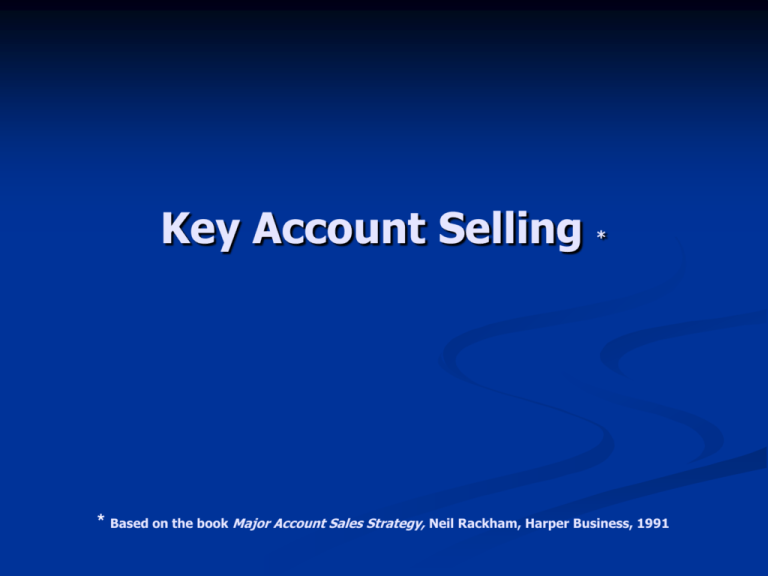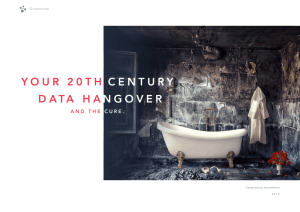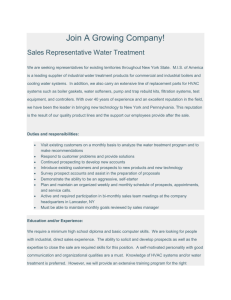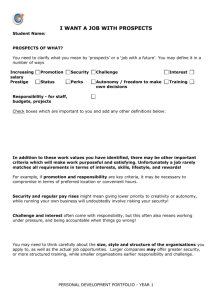Major Account Selling
advertisement

Key Account Selling * * Based on the book Major Account Sales Strategy, Neil Rackham, Harper Business, 1991 Key Account Selling Purpose – – To focus on developing new business. To focus on selling important, large new accounts. Goals – – To teach you that key account selling techniques are different from old-fashioned transactional selling. To teach you these new selling techniques. Key Account Selling Benefits – – – You will develop new business from large accounts. You will learn a skill in great demand in today’s business climate (no more loyalty). You will keep your job and get promoted. – List jockeys are out. Key Account Selling Seminar Take notes Ask questions Give examples, participate Purpose What is the purpose of your business? To create a customer – – Customers come first; without them there is no revenue, no profit. Customers’ needs come first. Objectives What are your sales objectives? 1 2 3 To get results for customers To develop new business To retain and increase current business – – 4 Presell Upsell To increase customer loyalty Strategies What are your sales strategies? To sell solutions to advertising and marketing problems Complete customer focus To reinforce the value of advertising and of your medium Strategies To create value for your product To become the preferred supplier – – – To establish, maintain, and improve relationships at all levels of the client and agency (keep agency informed) To provide the best research, information, and advice To be customers’ marketing consultant by providing solutions Strategies To innovate – – – – New packages, new products, new promotions New creative approaches New technology “The only functions of an enterprise: marketing and innovation.” Peter Drucker Functions What are a salesperson’s key functions? 1 2 To position your product to have a differential competitive advantage To manage relationships and build trust – – – – – To To To To To create rapport empathize persuade cooperate build consensus Key Functions 3 To solve problems – – 4 5 Creativity Get results To create a sense of urgency To communicate effectively up, down, and across – – Keep your management and coordinator informed From the street, bring back market and competitor knowledge Key Account Selling People buy for their reasons, not yours. – – Key account selling is different. Large accounts have different reasons to buying. Old selling techniques are based on small, singletransaction selling: – – – Prospecting Qualifying Presenting Understanding Buying Decisions Phases of the buying process: – Recognition of needs: – – Prospects are no longer satisfied. Evaluation of options: – – Begins with confusing array of choices. – As options narrow, choices become clearer. Clear preference emerges. Understanding Buying Decisions – Resolution of concerns – – – – – – Most complex stage in major account selling Made over a period of time rather than on a single call. There are competing alternatives to choose from. There are penalties and risks if a bad decision is made. Concerns are often hidden--expressed in terms of price. Implementation Account Entry Strategy - With Defined Purchasing Channel Meet gatekeepers: – – Their job is to filter vendors. They influence access decisions, not purchase decisions. Meet influencers – – – Cannot make purchasing decisions. Have significant influence on decisions. Gatekeepers and influencers claim much more authority than they have. Account Entry Strategy - With Defined Purchasing Channel Meet decision makers – Those who have the power to give you an order. Account Entry Strategy - Without Defined Channel Seek A sponsor within the organization in one of three different areas of focus: – – – The focus of receptivity The focus of dissatisfaction The focus of power Account Entry Strategy - Without Defined Channel Seek a sponsor within the organization: – – – At the focus of receptivity At the focus of dissatisfaction At the focus of power Account Entry Strategy - Without Defined Channel The dangers of receptivity – – – Distraction Misrepresentation No presentation – Goal is to gain access to decision makers. The Focus Of Dissatisfaction Uncover and develop dissatisfaction. – – – – Most important elements of key account selling (requires great listening skills). Your best friend is the person who is the most dissatisfied (requires great empathy). Develop dissatisfaction to the point where action is an imperative (requires great questioning skills). Gain access to decision maker (requires patience). Effective Listening Adopt the proper attitude – Optimistic, open, confident, trusting, respecting and vulnerable Shut up and listen. The best sellers are the best listeners, not the best talkers. Listen actively: nod, use gestures, smile (responsive feedback). Concentrate on the speaker. Effective Listening Do not step on sentences. Do not respond to negatives too quickly. Do not think of a rebuttal. Respect the other side’s statements. Listen for themes. Listen for emotions (non-verbal clues). Listen in synchronization--don’t mimic. Selling At The Focus Of Power Never waste access by making these mistakes: – Failure to do homework – – Don’t ask stupid questions Failure to take control – No chit-chat. “I know how busy you are, so I want to use your time efficiently. If you agree, I’d like to propose three specific solutions in the next twenty minutes.” Mistakes (Cont’d) – Premature meetings – – Have solutions first. Inappropriate expectations – Don’t get inflated expectations about a fast, unilateral decision. Summary What have we learned so far? Phase One: Recognition Of Needs Uncovering opportunities – – Most important phase of major account selling. If done right, all else falls into place. At this stage, you’re identifying problems. Ask the Discovery Questions. – See workbook. Phase One: Recognition Of Needs Goals Of This Phase: – – – Uncover dissatisfaction - Without it, no sale. Develop dissatisfaction - Increase dissatisfaction until action is imperative. Selectively channel dissatisfaction - So that people at focus of dissatisfaction or power will feel it in areas where you offer the best solutions. Set call objectives: some action that moves the sale along. – – – – Not “to build relationships,” too vague. Better: “Get introduction to the marketing department.” Setting call objectives is critical. Must be specific and forward moving. Goals Peak Motivation Motivation Very Easy Goal Difficulty Very Hard Phase Two: Evaluations Of Options Positioning for competitive advantage – – Make sure prospects have passed the Recognition Of Needs Phase. Start creating value for your product/service. – – Create a killer presentation. See Checklist for Solutions-Based Presentations in workbook. – – Prospects are dissatisfied enough to take action and accept your solutions as good ones. Now they ask “How do I make the best choice?” – – – May be important influencers or an evaluation committee. May be a published media strategy or plan. May ask for several presentations. Knowing your competition is essential. Goals Of Evaluation Of Options Phase To uncover decision criteria – To influence decision criteria – – Find out which criteria prospects intend to use to make choices. Introduce new criteria prospects may not have considered. Influence relative importance of existing criteria. To maximize your perceived fit with criteria Differentiation Customers are not all the same (less successful salespeople think they are) – – Business needs, problems (rational) Personal needs (emotional) Price is not always the #1 issue (less successful salespeople think it is) Differentiation Differentiate according to prospects’ reasons for buying. – – Hard differentiators - Measurable, such as rate, ratings, promotions, demos. Easy to sell; tendency to underprice. Soft differentiators - Not quantifiable, such as service, trust, reliability, reputation, relationships, personal concern by seller about problems and results. Harder to sell, take longer to establish. Go to Exercise #1 in the workbook. When prospects take time to think and evaluate, soft differentiators become more important. – – Do not rush prospects, emphasize soft differentiators, don’t try to close. Everyone wants a quality product. Help customers develop a definition of quality: No preemptions, precise targeting, less clutter, more product separation, product exclusivity, responsive service. Phase Three: Resolution Of Concerns As the size of the decision grows: – – – – So does the concern and fear about the risk of making an expensive mistake. More people become involved, and political concerns increase. The number and strength of competitors increase. Concerns about credibility, competence, and reputation become greater. – – Because of the number of concerns, the longer it takes to decide. You cannot speed up the process with a clever close. Concerns about implementation grow. Relationships, service, and support become the key. Goals Of The Resolution Of Concerns Phase To discover if consequence issues exist. – Consequences are deep-seated fears that are more dangerous than concerns. – – – “Do I really want to do business with that company?” What will happen to my career if this goes wrong?’ Prospects often express concerns, but consequences are hidden. To uncover and clarify any consequences issues. – Get them out in in the open if possible. Difficult. Dig deep. To help prospects resolve consequences issues. – You can only help to resolve issues. Since they only exist in prospects’ minds, you cannot resolve these issues, only help. Price Often A Mask For Consequences Issues A prospect’s first concern is often price. – Last issue is often price. – Then it diminishes as selling progress and value is created. Typically a mask for consequences issues. Price is not just CPM or CPP it includes real and perceived political, implementation, and other risks. Return On Investment Analysis ROI analysis helps overcome concerns and resolve consequences issues. See ROI analysis in workbook. No Pressure The larger the potential sale, the less effective closing techniques are. Putting pressure on a person who is worried about making a decision increases worries and fears. Phase Four: Implementation Immediately after a sale you must put in more effort, not less. The implementation phase begins as soon as you get an order. – – – Buyer’s remorse always sets in – fears are greatest at the beginning of implementation. Anticipate how the buyer feels. Continual communication and immediate responsiveness are absolutely vital. Phase Four: Implementation Service so as to make customers raving fans. The best order is always the second one – that’s when prospects become a customer. – Sell for the second order the moment you get the first one. See workbook for a sales service survey. Implementation Develop, don’t just service accounts. – – – Without a goal for increased business, service gets soft. When the goal is to protect existing business, competitors will hunt and accounts will look for improvements. Make every service call one that tries to expand the business – this effort gets renewals. Implementation Document good news. – – – – Never give accounts a reason to ask “What have you done for me lately?” Make stewardship reports. Conduct new audits to reassess marketing goals. Influence future decision criteria. Implementation Your relationship is either getting better or it’s getting worse. – – – What you did yesterday is history. Complacency is the worst sales sin. “Only the paranoid survive.” Andrew Grove. Types Of Salespeople Farmers Type of Account Current customer Hunters Prospect Evaluation Process Ratings, weight, reach, frequency, price, clicks Results, solutions, goal achievement Evaluation Focus Easily measured Difficult to measure Key Selling Skills Negotiating, servicing, maintaining relationships Problem-solving, presenting, closing Key characteristics Short-term focus, impatient, complacent, play not to lose Long-term focus, competitive, disciplined, play to win New Types Of Salespeople Farmers Hunters Levels of client contact Single level Multi level Focus Product, customer’s personal needs Customer, business needs, solutions Primary interest Self Customer Types of Salespeople Hunters do better with larger, key accounts. Salespeople: “Know thyself.” Sales management: “Know thy salespeople.” Summary What have your learned?



